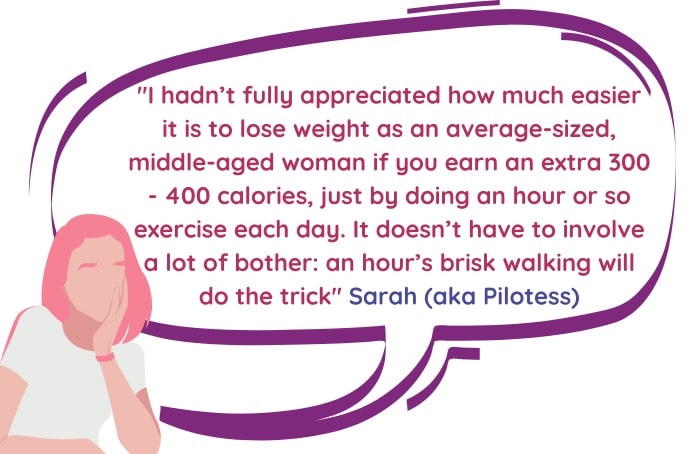How much Should I Walk to Lose Weight: Easy Guide For Beginners
People barely ever have time for physical activity in this fast-paced world. Increased bodily inactivity contributes to several ailments, including obesity and heart disorders. Further, the flexibility and mobility of joints are seriously reduced.
Walking is a low-impact workout that is incredibly beneficial to the body. After a long day, walking loosens tight muscles, boosts mood, eases tension, and strengthens the muscles in the thighs and calves.
It’s convenient and more straightforward to fit walking into daily practices at home and work. Walking may be controlled independently regarding frequency, course, and intensity. It may be regularly embraced into everyday life and be an incremental modification that turns effort into practice.

Can You Actually Lose Weight By Walking?
Walking is a vigorous, low-impact cardiovascular practice that raises heart rate and improves blood flow. It is an uncomplicated and suitable path to being active that doesn’t reach for expensive gear or specialized workouts.
Walking has become the perfect approach to keeping active because getting a certain number of steps may be tricky.
Walking boosts blood flow throughout the body, which reduces BP. It can increase energy levels by producing chemicals like endorphins.
Endorphins make you feel calmer by relieving stress and improving your mood, memory, and mental abilities. It’s a beautiful approach to managing your weight as well. It enhances non-exercise activity thermogenesis, or N.E.A.T., which contributes to calorie expenditure and helps maintain weight.
The ACSM advises the following types of exercise to maintain health and aid in weight loss:
For maintaining and improving health, 150 weekly minutes
Weight-loss prevention: 150–250 minutes per week
reduces body weight: 225–420 minutes per week
200–300 minutes per week are advised for weight loss after losing weight.

Can Walking Help You Lose Weight?
The many factors involved make it difficult to anticipate how much weight a person may lose when walking, but they can expect to burn roughly 100 calories every 1000 steps.
In general, how frequently you exercise (in terms of days per week), how long you exercise, and how hard you exercise will all affect how much weight you expect to lose.
If a typical 40-year-old woman who weighs 165 pounds and is 5’4″ started walking for an hour 5 times a week instead of being sedentary, she may lose 5 pounds in 2 months.
She would need to adopt restorative dietary changes resulting in a low-calorie diet (roughly 100 calories daily).
The 5 pounds can be kept off with a continuous workout and a balanced diet, but walking alone is doubtful to lead to further weight loss.
A fit person will likely feel better by boosting their physical activity and improving their nutrition.
However, you might not lose weight if you make dietary and activity adjustments. Your individual genes, metabolism, age, amount of physical activity, stress levels, and even sleep may affect whether you lose weight.
Additional benefits of walking include
- More significant reduction in cholesterol.
- Improved cardiac health
- Reduced BP
- Improved bone health
- Lower incidence of osteoporosis
- Reduced diabetes risk and different forms of cancer, especially breast and colon cancer
- Encourages good mental health
- Betters your sleep quality
- Increases insulin sensitivity
Walking has advantages beyond health and weight loss..
- It is totally free!
- No specialized tools are required.
- It is eco-friendly.
- It is possible to do it in basically any place.
- It can be a friendly, social activity and a superb way to start youths moving together.
How Do You Get Started with Your Walking Routine?
Choose a trail, then start walking – it’s one of the most straightforward workout regimens. You only need to wear comfy shoes; you don’t need to buy costly footwear or other accessories.
Walking at a rate of approximately 3 miles per hour, or 1 mile in 20 minutes, is an appropriate starting point.
To burn roughly 1,000 calories, or if you’re searching for a standard to compete with, aim to increase your step count to 10,000.
How Can You Walk Longer And Burn More Calories?
Changing the terrain may amplify your walking pattern and get a full-body workout.
The plight and intensity of the walk are boosted by walking uphill or tilting the treadmill. Modifying your walking speed at precise points can also be incorporated. If you’re outdoors, walk quickly from one stop sign to the next before slowing down till you reach your next stop sign. If you’re on a treadmill, you should walk for 3 minutes at a relaxing rate before raising your speed for the final minute or two.
You may also add weights, but avoid hand weights and invest in a weighted vest instead, which will let you exert more effort without placing undue strain on your joints.
Try something as easy as swinging your arms if you’re scouring for a no-equipment strategy to burn extra calories. According to the ACE research, strong arm movement burns more calories.
Although it may seem unfamiliar, vigorously pumping the arm up and down amplifies the workout’s intensity.
Conclusion
To summarize, walking is a low-impact movement with many health advantages. Boosting metabolism contributes to restoring general bodily functions. Walking quickly for 30 minutes can burn 150 calories on average. A regular walking program also helps in weight loss and effective weight management.
While walking has many benefits, it’s essential to strike a balance between exercise and eating. Walking and diet both greatly contribute to weight loss. Incorporating a walking habit with a healthy, balanced diet decreases the threat of metabolic conditions, including obesity and heart problems.
Frequently Asked Questions
Yes, walking regularly for 30 minutes can help you lose weight. Walking boosts weight loss and improves calorie burn when routinely done. Walking at least 5 days a week may burn 500–1000 calories. 30 minutes of fast walking will help you burn 100–200 calories.
Yes, walking is a great physical exercise for weight management. You may burn 150 kcal by adding 30 minutes of active walking to your regular practice. Regular walking aids in weight loss and abdominal fat loss. It is important to remember that you will walk farther and burn more calories the faster your speed.
It’s essential to be aware that your weight and walking pace, among other things, affect how many calories you burn when walking. A 45-minute to 1-hour fast walk helps you lose weight and tones your calves and leg muscles. Also, it burns extra calories to aid in weight management and reduction. Consistency is vital, even though the process takes time.
Losing weight is helped by engaging in an hour of fast walking or 10,000 steps daily. More than simple walking, though, is needed. A calorie-restricted diet incorporated with fast exercise for around 45 minutes will help you lose weight successfully. Avoid sugary drinks, manage your appetite, and limit your consumption of processed meals. You should walk steadily for 10,000 steps every day to lose weight.






